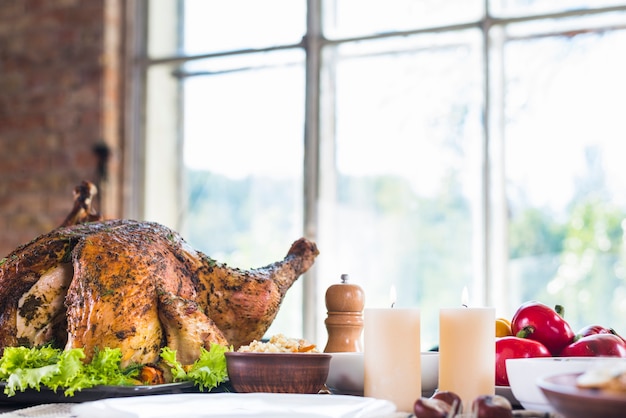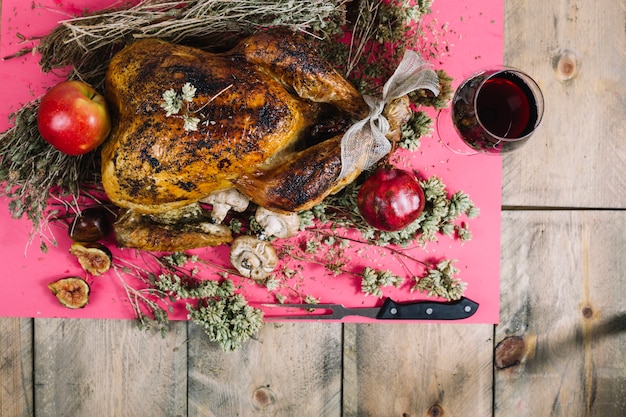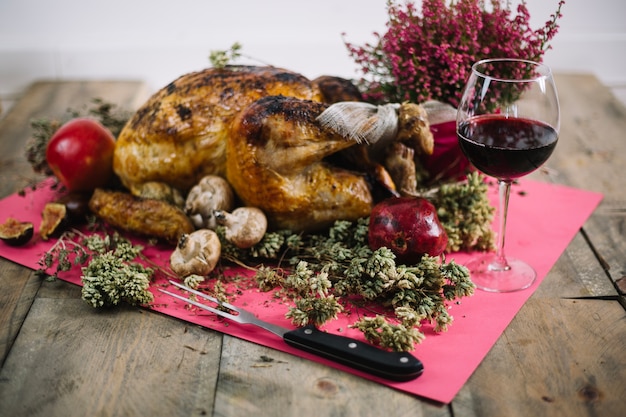Imagine this: a mountain of a turkey, a magnificent 17lb bird, ready to grace your table for a truly memorable festive feast. But with a bird this size, you might be thinking, "How on earth do I cook it without turning it into a dry, overcooked nightmare?" Trust me, I've been there, and I'm here to share my secrets to a juicy, flavourful roast turkey that will have your guests singing your praises.
This isn't just any recipe. It's a journey, a guide to take you from choosing the perfect bird to carving it up like a seasoned chef. We'll cover every step, from brining and stuffing to roasting and resting, adding in those little tips and tricks I've picked up over the years. So, grab your apron, get ready for a culinary adventure, and let's make this turkey a star!
(Part 1) The Turkey: A Look at Your Star Player

1. Choosing the Right Turkey: A Matter of Quality
A 17lb turkey is a serious commitment, so let’s make sure we start with the right one. For a truly special roast, I always choose a free-range turkey. They just have a richer flavour, a bit more depth. Plus, it feels good to know the bird had a bit more space to roam around. For me, it’s a no-brainer. And when it comes to fresh versus frozen, I'll always go for fresh. A frozen turkey takes a bit longer to thaw, and I find the flavour just isn't as good.
2. Thaw Time: Patience is Key
So, you've got your turkey, but it's probably frozen solid. Don't even think about thawing it on the counter - it's a food safety risk. Instead, put it in the fridge and give it plenty of time. A 17lb bird will take a good 3-4 days to thaw completely. Yes, it's a long wait, but it's worth it for a juicy, evenly cooked turkey.
(Part 2) Brining for Success: Unlocking the Secret to Juiciness

1. The Science Behind Brining: Why it Works
Now, this is a game-changer. Brining isn't just some fancy chef trick. It's science! You see, brining involves submerging your turkey in a salt-water solution, which draws moisture into the meat, making it incredibly juicy. For a seriously impressive roast, brining is an absolute must. Trust me, your taste buds will thank you for it.
2. My Go-To Brine Recipe: A Symphony of Flavour
My brine recipe is a bit of a secret weapon. For a 17lb turkey, I use:
- 1 gallon of water
- 1 cup of kosher salt
- 1 cup of sugar
- 1/2 cup of lemon juice
- 1 tablespoon of black peppercorns
- 1 bay leaf
- 1 teaspoon of thyme
- 1 teaspoon of rosemary
Don't be afraid to experiment. Some people swear by adding a splash of apple cider vinegar, which is said to give the turkey a beautiful golden hue. But really, the key is to use good quality ingredients, and you'll be on your way to a truly delicious roast.
3. The Brining Process: Letting the Magic Happen
Now, you've got your brine, but you need a container to hold your turkey. I always use a big plastic tub - the kind you can get at a hardware store. Make sure it's big enough to fully submerge your turkey in the brine, with plenty of space to spare. Then, pop it in the fridge and let it hang out there for at least 12 hours, or even up to 24 hours for maximum juiciness. Let the salt work its magic, and soak up all that delicious flavour.
(Part 3) The Stuffing Game: Flavourful Sides and Safe Practices

1. A Classic Savoury Stuffing: A Festive Tradition
Stuffing is a bit of a controversial topic, but for me, it's a must-have. A classic sausage and herb stuffing adds an incredible burst of flavour and texture. However, there's a crucial safety rule: never cook stuffing inside the turkey! It's a recipe for food poisoning. Instead, cook your stuffing separately in a baking dish.
2. My Go-To Stuffing Recipe: A Taste of Home
My stuffing recipe is simple, but it packs a punch:
- 1 lb of pork sausage
- 1 cup of chopped onions
- 1 cup of chopped celery
- 1 cup of chopped apples
- 1 cup of dried cranberries
- 1 cup of bread cubes
- 1/2 cup of chicken broth
- 1 teaspoon of dried sage
- 1 teaspoon of thyme
- 1/2 teaspoon of black pepper
First, I brown the sausage in a pan, then add the rest of the ingredients and mix everything together. Pop it in a 350°F oven for about 30 minutes, or until it's golden brown and cooked through.
(Part 4) The Roasting Ritual: Mastering the Art of Perfect Cooking
1. Prepping the Turkey: A Ritual of Flavour
Alright, so your turkey is brined, your stuffing is ready, and the stage is set. Now, pat your turkey dry with paper towels. Remove any giblets that might be inside. Next, give it a good rub with butter, olive oil, or even a mix of both. This will create a beautiful, crispy skin. And don't forget the salt and pepper! Season generously - it's the key to unlocking those delicious turkey flavours.
2. The roasting timetable: Patience and Planning
Here's where things get serious. A 17lb turkey is a marathon, not a sprint. You've got to be prepared. I always use the rule of thumb: about 15-20 minutes per pound. For a 17lb turkey, that's 4.25-5.6 hours in the oven. Yes, it's a long time, but it's worth the wait for a juicy, perfectly cooked bird.
3. The Temperature Game: The meat thermometer is Your Friend
Remember, every good chef has their tools. In this case, your tool is a meat thermometer. It's the only way to know for sure if your turkey is cooked through. Insert it into the thickest part of the thigh, making sure it doesn't touch the bone. For a turkey to be fully cooked, it needs to reach 165°F. No exceptions!
4. roasting techniques: Choosing the Right Approach
Now, there are a few different ways to roast a turkey. I prefer using a roasting pan with a rack. This allows air to circulate around the bird, ensuring even cooking. If you're using a smaller roasting pan, you might need to baste your turkey every 30-45 minutes. This involves spooning juices from the pan over the bird to keep it moist. I find a mixture of turkey drippings, broth, and butter works wonders.
(Part 5) Resting Is Key: Let the Juices Redistribute
Once your turkey hits that magical 165°F, resist the urge to carve it right away. Give it a good 30-minute rest before you start slicing. This allows the juices to redistribute throughout the meat, resulting in a more succulent and juicy turkey.
(Part 6) Carving Like a Pro: The Art of Slicing Perfection
1. The Tools of the Trade: Your Carving Toolkit
To carve your turkey with confidence, you need a sharp carving knife and a cutting board. I also like to keep a pair of kitchen shears on hand for cutting through bone. It's all about having the right tools for the job.
2. The Steps to Success: A Step-by-Step Guide
Start by removing the legs and thighs from the turkey. Then carve the breast into slices, working against the grain. You can also carve the wings for extra meat. Remember, patience is key. Take your time, and don't rush the process.
(Part 7) Leftovers - A Feast for Days: Turning Leftovers into Delicious Treats
Okay, so your turkey is carved and devoured, but don't even think about tossing out those glorious leftovers! They're a culinary goldmine, ready for creative transformations. Here are a few ideas to inspire your post-turkey feast:
1. turkey sandwiches: A Classic for a Reason
There's nothing quite like a classic turkey sandwich. I love using leftover turkey, cranberry sauce, and some crispy lettuce on toasted bread. It's a simple but satisfying way to enjoy those delicious leftovers.
2. turkey soup: A Hearty comfort food
A bowl of turkey soup is the perfect answer to a cold evening. I throw in some leftover turkey, vegetables, and broth for a hearty and comforting meal.
3. turkey salad: A Light and Refreshing Option
For a lighter lunch or dinner, try a turkey salad. Mix chopped turkey with mayonnaise, celery, onion, and your favorite herbs. Serve on a bed of greens or in a sandwich.
(Part 8) FAQs: Answers to Your Turkey Questions
1. How long do I cook a 17lb turkey for?
Remember the rule of thumb: 15-20 minutes per pound. For a 17lb turkey, that's 4.25-5.6 hours in the oven. But remember, always use a meat thermometer to ensure the turkey is cooked to an internal temperature of 165°F.
2. What if my turkey is still pink after roasting?
Don't panic! The color of the meat isn't always a reliable indicator of doneness. The only way to be sure is to use a meat thermometer. If the internal temperature reaches 165°F, then it's fully cooked.
3. What do I do if my turkey is overcooked?
It's always better to undercook a turkey than overcook it. An overcooked turkey will be dry and tough. However, you can try to salvage the situation by carving the turkey and then basting it with pan drippings or broth.
4. Can I cook the stuffing inside the turkey?
Absolutely not. Cooking stuffing inside a turkey can be a food safety risk, as the stuffing may not reach a safe temperature. It's much safer to cook the stuffing separately in a baking dish.
5. How do I make sure my turkey skin is crispy?
To get crispy turkey skin, rub the turkey with butter, olive oil, or a combination of both. Roast the turkey uncovered, and try not to baste too often, as this can make the skin soggy.
So there you have it – a complete guide to roasting a 17lb turkey. It's all about preparation, patience, and a touch of culinary magic. With a bit of planning and some insider tips, you'll be able to create a stunning, flavourful turkey that will make your holiday meal truly special.
Everyone is watching

Corn on the Cob: The Ultimate Guide to Perfectly Cooked Ears
Healthy MealsAh, corn on the cob. Just the name evokes images of sunny days, barbecues, and that sweet, juicy flavour that ...

Perfect Pork Roast Oven Cooking Time: A Guide to Delicious Results
Healthy MealsThere's something truly satisfying about a perfectly roasted pork. The aroma alone is enough to make your mout...

Ham Cooking Time: How Long to Bake, Smoke, or Boil a Delicious Ham
Healthy MealsAh, ham. It's a classic, isn't it? A real crowd-pleaser, especially around holidays. And when done right, it'...

Scallops: The Ultimate Guide to Perfect Cooking
Healthy MealsAh, scallops. Those delicate, sweet, and utterly delicious morsels of the sea. They hold a special place in my...

Spaghetti Squash: The Ultimate Guide to Cooking and Serving
Healthy MealsRemember that time you saw spaghetti squash at the supermarket, looking all bumpy and strange, and thought, "W...
